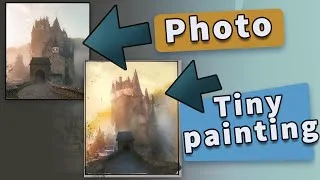Introduction:
What is Digital Landscape Art
Digital landscape art stands at the intersection of creativity and technology, reshaping the canvas for artistic expression in profound ways.
This evolving genre transcends traditional methods, embracing the dynamic possibilities offered by digital tools and software.
- As artists migrate from physical canvases to digital platforms,
- the fusion of graphic tablets,
- styluses,
- and sophisticated software like Adobe Photoshop
- and Procreate gives rise to a realm where pixels replace paint,
- and limitless creative landscapes come to life.
This introduction sets the stage for an exploration into the captivating world of digital landscape art,where the traditional meets the contemporary,and the brushstroke extends into the realm of algorithms and virtual dimensions.

In the realm of art, the emergence of digital landscape art represents a dynamic intersection between traditional artistic expression and cutting-edge technology.This genre has witnessed a transformative journey, transitioning from conventional methods to the realm of pixels and screens.
Evolution of Tools and Software
- Graphic tablets and styluses have replaced traditional brushes and canvases.
- Software platforms such as Adobe Photoshop, Corel Painter, and Procreate offer powerful digital canvases for artists
Advantages Unleashed by Digital Mediums
- The ability to undo and redo facilitates experimentation without the fear of irreversible mistakes.
- An expansive spectrum of colors and customizable palettes provides artists with unparalleled creative freedom.
- Non-destructive editing features empower artists to refine their work iteratively.
Exploring Techniques in Digital Landscape Art
- Brush strokes and blending techniques are applied digitally, allowing for precision and control.
- Layering is a pivotal aspect, enabling artists to build depth and texture in their landscapes.
- Filters and effects add nuance, transforming the visual narrative of the artwork.
Navigating Challenges in the Digital Realm
- Acquiring proficiency with digital tools poses a learning curve for artists transitioning from traditional methods.
- Striking a balance between traditional and digital techniques requires a nuanced understanding of both worlds.
- Managing file sizes and storage considerations necessitates a strategic approach to workflow.
Artistic Freedom and Innovation

- The digital landscape offers boundless possibilities for creating imaginary worlds and pushing artistic boundaries.
- Artists can seamlessly combine various elements, experimenting with styles and genres in ways that were once challenging in traditional mediums.
Community and Collaboration in the Digital Sphere
- Online platforms serve as hubs for artists to share their work, receive feedback, and engage in collaborative projects.
- Digital art communities foster growth, inspiration, and the exchange of ideas among artists worldwide.
Commercial Applications and Impact on Industries

- Digital landscape art finds applications in video games and virtual reality, enhancing immersive experiences.
- Illustrations created digitally are prevalent in books, magazines, and websites.
- Commissioned digital art projects cater to the diverse needs of clients and businesses.
The Interplay between Traditional and Digital Art

- Boundaries between traditional and digital art continue to blur as artists seamlessly integrate digital techniques into their traditional artworks.
- Debates within the art world persist regarding the authenticity and acceptance of digital art as a legitimate form of artistic expression.
Empowering Artists Through Education
Online tutorials, courses, workshops, and webinars contribute to the continuous learning of artists in this rapidly evolving digital landscape.
The importance of embracing new tools and techniques is emphasized, encouraging artists to stay abreast of advancements.
there are some questions for you
1.Question:
What tools and software are commonly used in creating digital landscape art?
Answer:Artists often use graphic tablets and styluses in conjunction with software platforms like Adobe Photoshop, Corel Painter, and Procreate.
2.Question:
What advantages does the digital medium offer to artists in comparison to traditional methods?
Answer:Digital art provides advantages such as the ability to undo and redo, a vast color palette, and non-destructive editing, offering artists greater flexibility and creative freedom.
3.Question:
How do techniques like brush strokes, layering, and filters contribute to the visual appeal of digital landscape art?
Answer:These techniques allow artists to create precise strokes, build depth and texture through layering, and add nuanced effects, enhancing the overall visual narrative of their artworks.
4.Question:
What challenges do artists face when transitioning from traditional to digital methods?
Answer:Artists may encounter challenges associated with the learning curve of digital tools, balancing traditional and digital techniques, and managing file sizes and storage considerations.
5.Question:
How do online platforms contribute to the sense of community and collaboration among digital landscape artists?
Answer:Online platforms serve as hubs for sharing work, receiving feedback, and engaging in collaborative projects, fostering a global community of artists.
6.Question:
What are some commercial applications of digital landscape art?
Answer:Digital landscape art finds applications in video games, virtual reality experiences, illustrations for books and magazines, as well as commissioned projects for clients and businesses.
7.Question:
How does the ongoing debate about the authenticity of digital art impact the perception of digital landscape art?
Answer:The debate influences how digital landscape art is viewed within the broader art world, prompting discussions about its legitimacy and acceptance.
8.Question:
How do artists balance the integration of traditional and digital techniques in their artworks?
Answer:Artists navigate this balance by seamlessly incorporating digital techniques into traditional methods, blurring the lines between the two and contributing to the evolving nature of artistic expression.
9.Question:
How do online resources like tutorials and workshops contribute to the continuous learning of digital landscape artists?
Answer:Online resources play a crucial role in the continuous learning process, offering tutorials, courses, and workshops that help artists stay updated with evolving tools and techniques.
10.Question:
Considering the fusion of creativity and technology, what potential innovations does the future hold for digital landscape art?
Answer:The future promises continued innovation in digital landscape art, with potential advancements in tools, techniques, and applications, pushing the boundaries of artistic expression.
Conclusion:
Navigating the Digital Canvas’s Infinite Horizons
In conclusion, digital landscape art stands as a testament to the ever-evolving nature of artistic expression.As artists navigate the digital canvas, they not only redefine their creative processes but also contribute to a broader cultural shift in the perception and acceptance of digital art.
The fusion of creativity and technology in this realm opens up infinite horizons, promising a future where the boundaries between the traditional and digital worlds are transcended for the enrichment of artistic endeavors.
Why Technology is Good: Unveiling the Multifaceted Benefits in the Modern Era.





